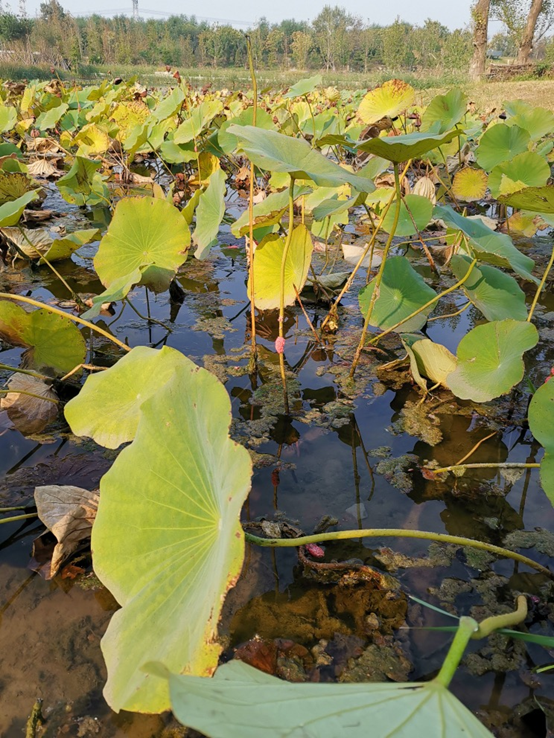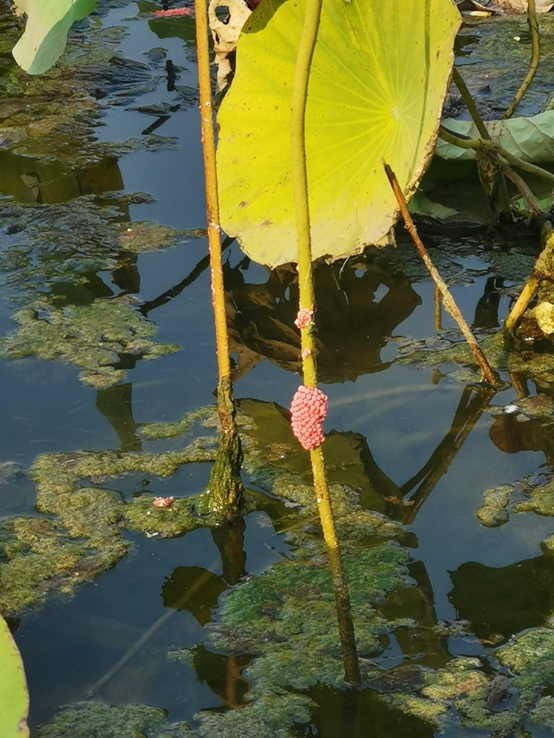On October 7th, volunteers reported to China Biodiversity Conservation and Green Development Foundation (CBCGDF) that suspected eggs of Pomacea canaliculata were found in Wenyuhe Park in Beijing. Pomacea canaliculata, commonly known as the golden apple snail or the channeled apple snail, is a species of large freshwater snail with gills and an operculum, an aquatic gastropod mollusc in the family Ampullariidae, the apple snails. The species is considered to be in the top 100 of the "World's Worst Invasive Alien Species".
This species lives in freshwater lake, river, pond and swamp habitats and tolerates a wide range of temperatures. In natural settings, they rely on grasses and other emergent vegetation growing along the perimeter of bodies of water to lay their eggs. Where invasive, they can utilize crops such as rice and taro as a substrate for reproduction.
Pomacea canaliculata is extremely polyphagous, feeding on vegetal (primarily macrophytophagous, feeding on floating or submersed higher plants), detrital, and animal matter. Diet may vary with age, with younger smaller individuals feeding on algae and detritus, and older, bigger (15mm and above) individuals later shifting to higher plants. This species negatively impacts rice and taro agriculture worldwide where it has been introduced.
In temperate climates, the egg-laying period of this species extends from early spring to early fall. while in tropical areas reproduction is continuous. The duration of the reproductive period of P. canaliculata decreases with latitude, to a minimum of six months in the southern limit of its natural distribution. Adult females oviposit on emergent vegetation at night but will also lay their eggs on rocks and manmade surfaces like boats. Once laid, the eggs take approximately two weeks to hatch, during which time the bright pink or orange coloration of the egg’s fades.
Crude cyclotide extracts from both Oldenlandia affinis and Viola odorata plants showed molluscicidal activity comparable to the synthetic molluscicide metaldehyde. Because submerging developing eggs below the water reduces hatching success, manipulating the water level in agricultural fields and dammed reservoirs may provide a tool for controlling invasive populations.
The State Environmental Protection Administration of China listed Pomacea canaliculata as one of the most dangerous agricultural alien invasive organisms.
Up to now, CBCGDF has quickly deployed related work, contacted relevant experts, and mobilized citizen scientists.
A professor at Peking University suggested that publicity on the harmfulness of Pomacea canaliculata should be strengthened because the public's awareness of this species is still insufficient. Because it has always appeared in the south, and now it appears in the north, people should be vigilant. Some plant experts said that further confirmation is needed, because Pomacea canaliculata may not be able to survive the winter in Beijing. If so, it will be fine.
An expert from Shanghai Ocean University said that the habitat of Pomacea canaliculata has been expanding rapidly in recent years, and it really needs attention. Can apply for projects to relevant parties to investigate the current situation of the distribution area. China now lacks such basic data. Can also unite with colleges and universities to mobilize college students to do a good job.
At noon on October 8, the staff of CBCGDF had gone to Wenyuhe Park to conduct field investigations. At the same time, discuss countermeasures with relevant units and departments. Thanks to the relevant leaders of Beijing Municipal Bureau of Landscape Architecture and Wenyuhe Park Management Office for their support to the work of CBCGDF.




(Photo credit: CBCGDF volunteer)
By / Maggie
https://www.paypal.me/CBCGDFChina
http://www.cbcgdf.org/English/ConfirmDonaTion/0.html


(Please indicate "I read CBCGDF" in the payment notes, thank you!)
